An Ultra-Wideband Linear-to-Circular Polarization Converter Based on a Circular, Pie-Shaped Reflective Metasurface
Abstract
:1. Introduction
2. Metasurface Design and Method
2.1. Stokes Parameters
2.2. Parametric Analysis
3. Theoretical Analysis
4. Conclusions
Author Contributions
Funding
Institutional Review Board Statement
Informed Consent Statement
Data Availability Statement
Conflicts of Interest
References
- Akbari, M.; Farahani, M.; Sebak, A.R.; Denidni, T.A. Ka band linear-to-circular polarization converter based on multilayer slab with broadband performances. IEEE Access 2017, 5, 17927–17937. [Google Scholar] [CrossRef]
- Akbari, M.; Gupta, S.; Zarbakhsh, S.; Sebak, A.R. A linear-to-circular polarizer based on frequency selective surface operating 30 GHz applications. In Proceedings of the 2016 17th International Symposium on Antenna Technology and Applied Electromagnetics (ANTEM), Montréal, QC, Canada, 10–13 July 2016; IEEE: Piscataway, NJ, USA, 2016; pp. 1–2. [Google Scholar]
- Guariglia, E. Entropy and Fractal antennas. Entropy 2016, 18, 84. [Google Scholar] [CrossRef]
- Krzysztofik, W.J. Fractal geometry in electromagnetics applications from antenna to metamaterials. Microw. Rev. 2013, 1, 19. [Google Scholar]
- Hohlfed, R.G.; Cohen, N. Self-similarity and the geometric requirements for frequency independence in antennae. Fractals 1999, 7, 79–84. [Google Scholar] [CrossRef]
- Al-Gburi, A.J.A.; Ibrahim, I.B.M.; Zakaria, Z.; Ahmad, B.H.; Bin Shairi, N.A.; Zeain, M.Y. High gain of UWB Planar antenna utilizing FSS reflector for UWB applications. Comput. Mater. Contin. 2022, 70, 1419–1436. [Google Scholar] [CrossRef]
- Askari, H.; Hussain, N.; Choi, D.; Abu Sufian, M.; Abbas, A.; Kim, N. An AMC-based circularly polarized antenna for 5G sub-6 GHz communications. Comput. Mater. Contin. 2021, 69, 2997–3031. [Google Scholar] [CrossRef]
- Munk, B.A. Frequency Selective Services: Theory and Design; Wiley: New York, NY, USA, 2000. [Google Scholar]
- Hwang, K.C. A novel meander-grooved polarization twist reflector. IEEE Microw. Wirel. Compon. Lett. 2010, 20, 217–219. [Google Scholar] [CrossRef]
- Chen, H.; Ma, H.; Qu, S.; Wang, J.; Li, Y.; Yuan, H.; Xu, Z. Ultra-wideband polarization conversion metasurfaces. In Proceedings of the 2014 3rd Asia-Pacific Conference on Antennas and Propagation, Harbin, China, 26–29 July 2014; pp. 1009–1011. [Google Scholar]
- Yu, X.Y.; Gao, X.; Han, X.; Li, S.M.; Cao, W.P.; Yu, X.H.; Jiang, Y.N. High-performance terahertz polarization converter based on double V-shaped metasurface. IEEE Trans. Antennas Propag. 2015, 63, 3522–3530. [Google Scholar]
- Zhao, J.; Cheng, Y. A High efficiency and broadband reflective 90° linear polarization rotator based on anisotropic metamaterial. Appl. Phys. 2016, 122, 225. [Google Scholar] [CrossRef]
- Lin, B.Q.; Da, X.Y.; Wu, J.L.; Wi, L.; Fang, Y.W.; Zhu, Z.H. Ultra-wideband and high efficiency cross polarization converter based on anisotropic metasurface. Microw. Opt. Tech. Lett. 2016, 58, 2402–2405. [Google Scholar] [CrossRef]
- Zhu, H.L.; Cheung, S.W.; Chung, K.L.; Yuk, T.I. linear-to-circular polarization conversion using metasurface. IEEE Trans. Antennas. Propag. 2013, 61, 4615–4623. [Google Scholar] [CrossRef] [Green Version]
- Chen, H.; Wang, J.; Ma, H.; Qu, S.; Xu, Z.; Zhang, A.; Yan, M.; Li, Y. Ultra-wideband polarization conversion metasurfaces based on multiple plasmon resonances. J. Appl. Phys. 2014, 115, 154504. [Google Scholar] [CrossRef]
- Kaouach, H.; Dussopt, L.; Lanteri, J.; Koleck, T.; Sauleau, R. Wideband low-loss linear and circular polarization transmit-arrays in V-band. IEEE Trans. Antennas Propag. 2011, 59, 2513–2523. [Google Scholar] [CrossRef]
- Yu, N.; Aieta, F.; Genevet, P.; Kats, M.A.; Gaburro, Z.; Capasso, F. A broadband, background-free quarter-wave plate based on plasmonic metasurfaces. Nano. Lett. 2012, 12, 6328–6333. [Google Scholar] [CrossRef]
- Wang, L.; Hu, H.; Liu, K.; Jiang, S.; Zeng, W.; Gan, Q. Polarization management of terahertz extraordinary optical transmission through ultracompact L-shaped subwavelength patterns on metal films. Plasmonics 2014, 8, 733–740. [Google Scholar] [CrossRef]
- Martinez-Lopez, L.; Rodriguez, J.; Maetinez-Lopez, J.I.; Martynyuk, A.E. A multilayer circular polarizer based on bisected split-ring frequency selective surfaces. IEEE Antennas Wirel. Propag. Lett. 2013, 13, 153–156. [Google Scholar] [CrossRef]
- Tamayama, Y.; Yasui, K.; Nakanishi, T.; Kitano, M. A linear-to-circular polarization converter with half transmission and half reflection using a single-layered metamaterial. Appl. Phys. Lett. 2014, 105, 021110. [Google Scholar] [CrossRef] [Green Version]
- Li, Y.; Zhang, J.; Qu, S.; Wang, J.; Zeng, L. Achieving wide-band linear-to-circular polarization conversion using ultra-thin bi-layered metasurfaces. J. Appl. Phys. 2015, 117, 011129. [Google Scholar] [CrossRef]
- Lin, B.-Q.; Liv, L.; Guo, J.-X.; Wang, Z.; Huang, S.-Q.; Wang, Y.-W. Ultra-wideband linear-to-circular polarization conversion metasurface. China Phys. B 2020, 29, 104205. [Google Scholar] [CrossRef]
- Chazizadeh, M.H.; Dadashzadeh, G.; Korshidi, M. A novel wideband electromagnetic band gap structure for circular polarization conversion. In Proceedings of the 2012 15 International Symposium on Antenna Technology and Applied Electromagnetics, Toulouse, France, 25–28 June 2012. [Google Scholar]
- Doumanis, E.; Goussetis, G.; Gomez-Tornero, J.L.; Cahil, R.; Fusco, V. Anisotropic impedance surface for linear to circular polarization conversion. IEEE Trans. Antennas Propag. 2012, 60, 212–219. [Google Scholar] [CrossRef]
- Moroya, T.; Makino, S.; Hirota, T.; Noguchi, K.; Itoh, K.; Ikarashi, K. Polarization conversion reflector using a metal-plate-loaded meander line. In Proceedings of the 2014 International Symposium on Antennas and Propagation Conference, Kaohsiung, Taiwan, 2–5 December 2014. [Google Scholar]
- Xia, R.; Jing, X.; Gui, X.; Tian, Y.; Hong, Z. Broadband terahertz half-wave plate based on anisotropic polarization conversion metamaterials. Opt. Mater. Express. 2017, 7, 977–988. [Google Scholar] [CrossRef]
- Li, F.; Chen, H.; Zhang, L.; Zhou, Y.; Xie, J.; Deng, L.; Harris, V.G. Compact high-efficiency broadband metamaterial polarizing reflector at microwave frequencies. IEEE Trans. Microw. Theory Tech. 2018, 67, 606–614. [Google Scholar] [CrossRef]
- Long, F.; Yu, S.; Kou, N.; Zhang, C.; Ding, Z.; Zhang, Z. Efficient broadband linear polarization conversion metasurface based on %-shape. Microw. Opt. Tech. Lett. 2020, 62, 226–232. [Google Scholar] [CrossRef]
- Zheng, Q.; Guo, C.; Vandenbosch, G.A.; Yuan, P.; Ding, J. Ultra-broadband and high-efficiency reflective polarization rotator based on fractal metasurface with multiple plasmon resonances. Opt. Commun. 2019, 449, 73–78. [Google Scholar] [CrossRef]
- Yan, M.; Wang, J.; Pang, Y.; Xu, C.; Chen, H.; Zheng, L.; Zhang, J.; Qu, S. An FSS-backed dual-band reflective polarization conversion metasurface. IEEE Access 2019, 7, 104435–104442. [Google Scholar] [CrossRef]
- Zhao, J.; Cheng, Y.Z.; Cheng, Z. Design of a photo-excited switchable broadband reflective linear polarization conversion metasurface for terahertz waves. IEEE Photonics J. 2018, 10, 1–10. [Google Scholar] [CrossRef]
- Jiang, Y.; Wang, L.; Wang, J.; Akwuruoha, C.N.; Cao, W. Ultra-wideband high-efficiency reflective linear-to-circular polarization converter based on metasurface at terahertz frequencies. Opt. Express. 2017, 25, 27616–27623. [Google Scholar] [CrossRef]
- Ma, H.F.; Wang, G.Z.; Kong, G.S.; Cui, T.J. Broadband circular and linear polarization conversions realized by thin birefringent reflective metasurfaces. Opt. Mater. Express. 2014, 4, 1717–1724. [Google Scholar] [CrossRef]
- Jia, Y.; Liu, Y.; Zhang, W.; Wang, J.; Wang, Y.; Gong, S.; Liao, G. Ultra-wideband metasurface with linear-to-circular polarization conversion of an electromagnetic wave. Opt. Mater. Express. 2018, 8, 597–604. [Google Scholar] [CrossRef]
- Li, S.; Zhang, X. An ultra-wideband linear-to-circular polarization converter in reflection mode at terahertz frequencies. Microw. Opt. Tech. Lett. 2019, 61, 2675–2680. [Google Scholar] [CrossRef]
- Jiang, S.C.; Xiong, X.; Hu, Y.S.; Hu, Y.H.; Ma, G.B.; Peng, R.W.; Sun, C.; Wang, M. Controlling the polarization state of light with a dispersion-free metastructure. IEEE Phys. Rev. X 2014, 4, 021026. [Google Scholar] [CrossRef] [Green Version]
- Zhang, Z.; Cao, X.; Gao, J.; Li, S. Broadband metamaterial reflectors for polarization manipulation based on cross/ring resonators. Radioengineering 2016, 25, 436–441. [Google Scholar] [CrossRef]
- Mao, C.; Yang, Y.; He, X.; Zheng, J.; Zhou, C. Broadband reflective multipolarization converter based on single-layer double-L-shaped metasurface. Appl. Phys. A 2017, 123, 767. [Google Scholar] [CrossRef] [Green Version]
- Zheng, Q.; Guo, C.; Ding, J. Wideband metasurface-based reflective polarization converter for linear-to-linear and linear-to-circular polarization conversion. IEEE Antennas Wirel. Propag. Lett. 2018, 17, 1459–1463. [Google Scholar] [CrossRef]
- Gao, X.; Yu, X.Y.; Cao, W.P.; Jiang, Y.N.; Yu, X.H. Ultra-wideband circular-polarization converter with micro-split Jerusalem-cross metasurfaces. Chin. Phys. B 2016, 25, 128102. [Google Scholar] [CrossRef]
- Lin, B.; Wu, J.-L.; Da, X.-Y.; Li, W.; Ma, J.-J. A linear-to-circular polarization converter based on I-shaped circular frequency selective surfaces. Appl. Phys. A Solids Surf. 2017, 123, 43. [Google Scholar] [CrossRef]
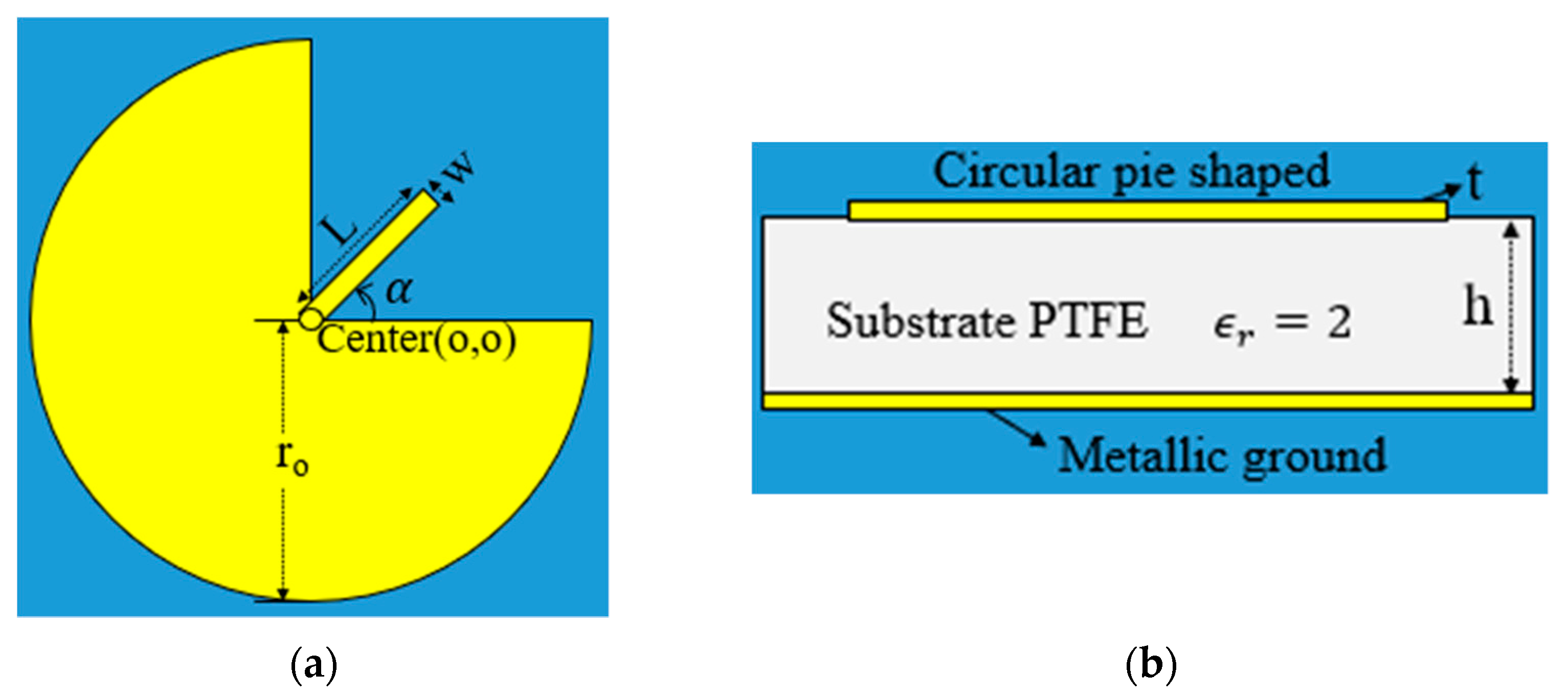
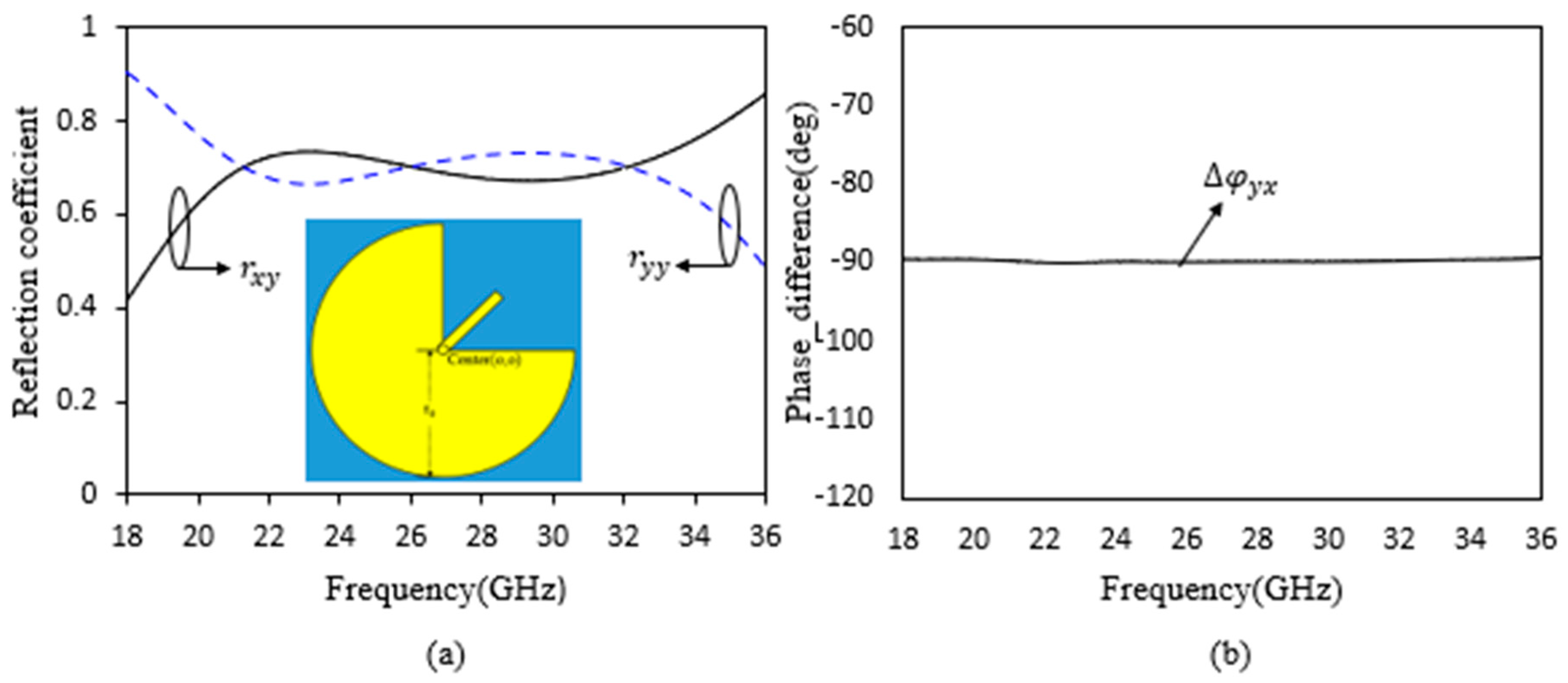



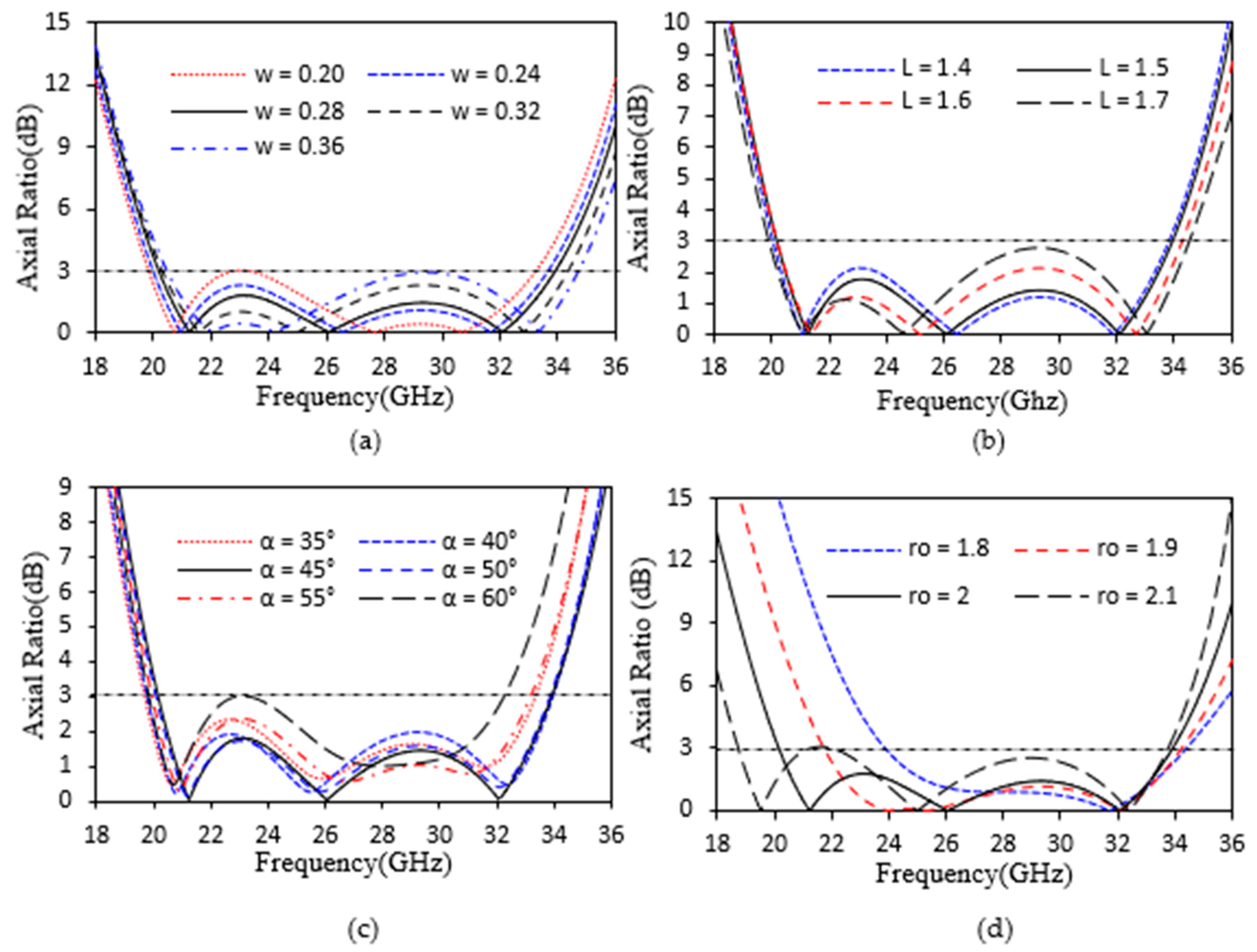

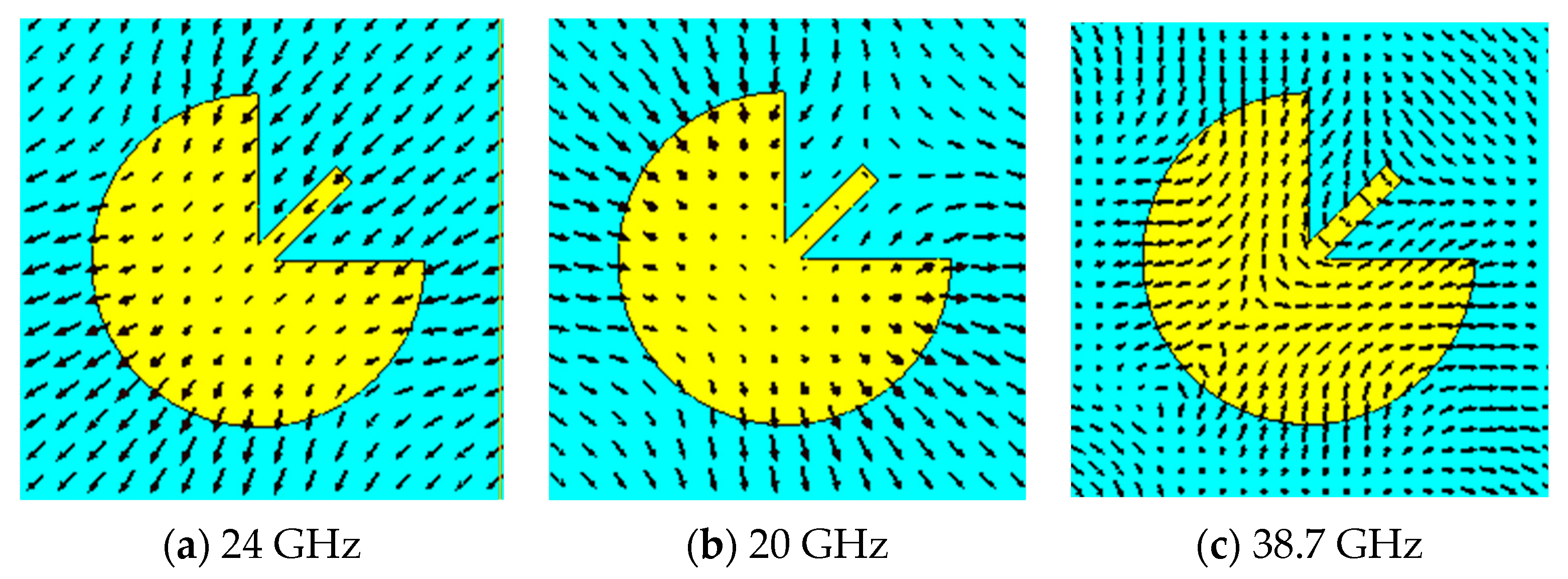
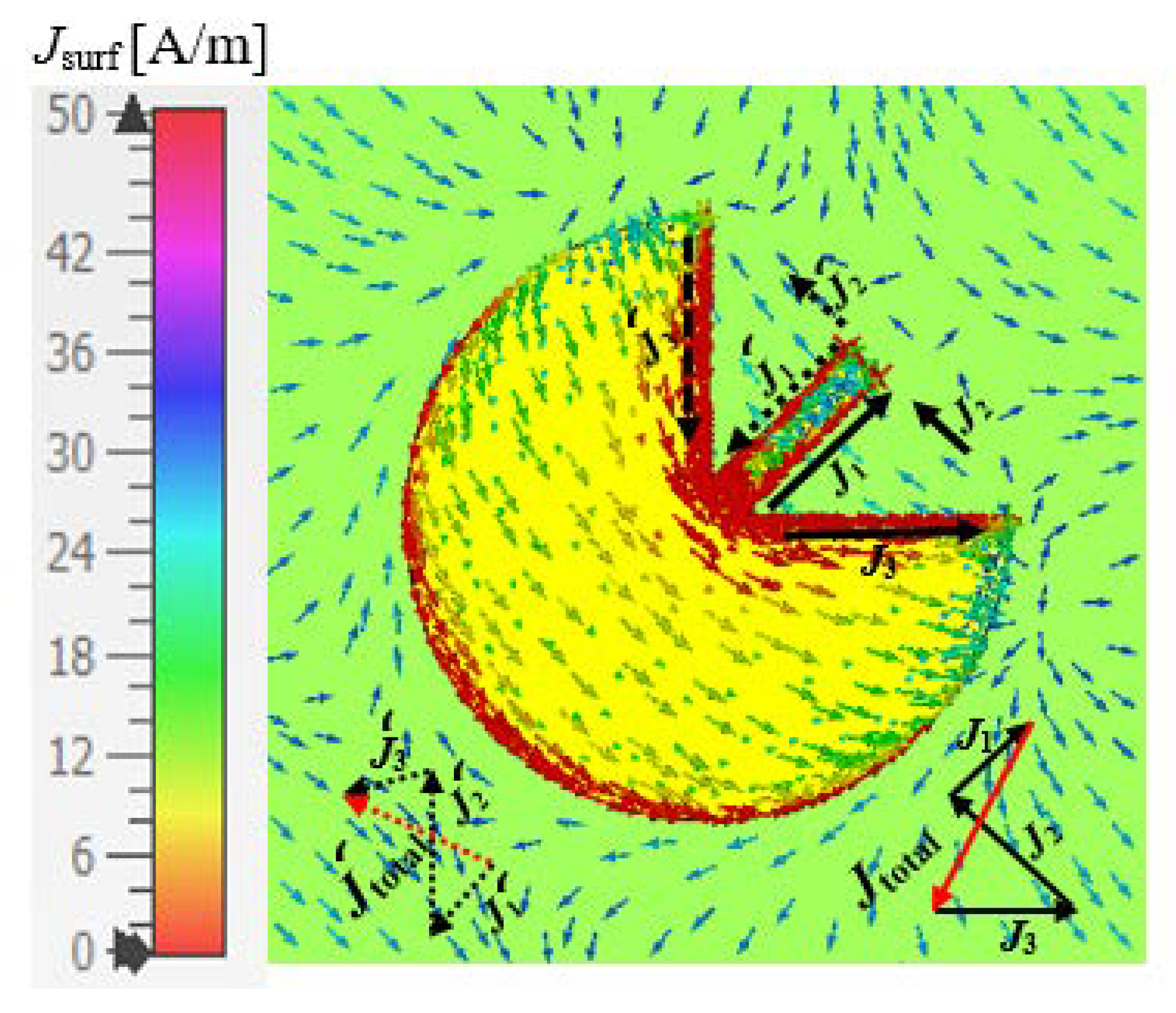
| Refs | Frequency Band (GHz) | Unit Cell (P) | Thickness | Performance | FBW (%) | PCR |
|---|---|---|---|---|---|---|
| [33] | 9.50–11.00 | 6.0 mm | 3 mm | LP to CP | 15.0 | N/A |
| [37] | 11.5–15.6 | 13.2 mm | 4 mm | LP to CP | 30.3 | N/A |
| [38] | 18.1–22.5 | 6.4 mm | 2.2 mm | LP to CP | 36.31 | N/A |
| [39] | 13.70–15.60 | 8.1 mm | 3.1 mm | LP to CP | 13 | N/A |
| [40] | 12.4–21.0 | 5.0 mm | 2.5 mm | LP to CP | 50 | N/A |
| [41] | 5.86–7.34 | 12.0 mm | 1.8 mm | LP to CP | 18.9 | N/A |
| This work | 20.18–33.93 | 6.0 mm | 1.6 mm | LP to CP | 50.8 | 98 |
Publisher’s Note: MDPI stays neutral with regard to jurisdictional claims in published maps and institutional affiliations. |
© 2022 by the authors. Licensee MDPI, Basel, Switzerland. This article is an open access article distributed under the terms and conditions of the Creative Commons Attribution (CC BY) license (https://creativecommons.org/licenses/by/4.0/).
Share and Cite
Majeed, A.; Zhang, J.; Ashraf, M.A.; Memon, S.; Mohammadani, K.H.; Ishfaq, M.; Sun, M. An Ultra-Wideband Linear-to-Circular Polarization Converter Based on a Circular, Pie-Shaped Reflective Metasurface. Electronics 2022, 11, 1681. https://doi.org/10.3390/electronics11111681
Majeed A, Zhang J, Ashraf MA, Memon S, Mohammadani KH, Ishfaq M, Sun M. An Ultra-Wideband Linear-to-Circular Polarization Converter Based on a Circular, Pie-Shaped Reflective Metasurface. Electronics. 2022; 11(11):1681. https://doi.org/10.3390/electronics11111681
Chicago/Turabian StyleMajeed, Abdul, Jinling Zhang, Muhammad Aqeel Ashraf, Saifullah Memon, Khalid Hussain Mohammadani, Muhammad Ishfaq, and Mun Sun. 2022. "An Ultra-Wideband Linear-to-Circular Polarization Converter Based on a Circular, Pie-Shaped Reflective Metasurface" Electronics 11, no. 11: 1681. https://doi.org/10.3390/electronics11111681
APA StyleMajeed, A., Zhang, J., Ashraf, M. A., Memon, S., Mohammadani, K. H., Ishfaq, M., & Sun, M. (2022). An Ultra-Wideband Linear-to-Circular Polarization Converter Based on a Circular, Pie-Shaped Reflective Metasurface. Electronics, 11(11), 1681. https://doi.org/10.3390/electronics11111681








